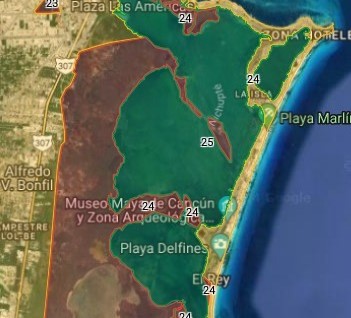

The construction works of the Nichupté bridge take more shape every day and although they remained stopped for months on the side of the Hotel zone, to give priority to the section that starts from the road distributor, the same progress that it presents makes evident the environmental impact in the area.
Just a few weeks ago, work restarted in front of Plaza Kukulcán, where the filling of a considerable area is already visible and where the lanes will be built to join the bridge that will cross the Nichupté Lagoon.
The permits for the Nichupté Bridge, granted by the Ministry of the Environment and Natural Resources (Semarnat), under the consent of the National Commission of Protected Natural Areas (Conanp), completely left aside the municipal and state ecological regulations that, among other things , they did not allow fillings in the lacunar body.
This way of “imposing” federal laws on local legislation facilitated permits to fill and build numerous projects on the side of the Nichupté Lagoon. Little by little, Cancun was left with very few windows to the sea and it seems that the same will happen on the side of the lagoon system.
Just behind Bonampak Avenue, where there are sports clubs, hospitals, private schools and corporate offices, is the route of the bridge that will lead to the elevated part over the body of water.
Although the project that was launched was selected among several options as one of the best that were presented at the time and its development is outside the conservation polygons of the Nichupté Mangrove Protected Natural Area, in practice its construction represents the devastation of a large area of mangroves, a situation that is visible through platforms such as Google Maps.
In the satellite images that can be consulted on any computer or mobile phone, the clearing of large areas of mangrove swamp is clearly seen, parallel to the extension of Nichupté Avenue, on one side of the Malecón Tajamar.
Another of the irregularities that are visible with this Google tool is a large stain of sediment that extends outside the mesh that the developers are required to place to prevent that waste that is released by the excavations to place the piles that will support the bridge damage the lagoon flora and fauna.
The recent damage to the Hotel zone due to the blockade of the Searching Mothers made it evident, once again, that it is urgent to have a third way to connect the city with the hotels, shopping malls and hundreds of businesses that are part of the tourist destination. most important in the country and the region.
The problem is that the environmental damage is incalculable and directly affects the natural heritage of Cancún. As reported REPORTUR.mxFrancisco Hernández, president of Asociados Náuticos de Cancún, denounced that the Nichupté lagoon “can’t take it anymore,” as it not only suffers the pressure of massive development on its coastline. (Nautical sector alerts about the decaying state of the Nichupté lagoon)






